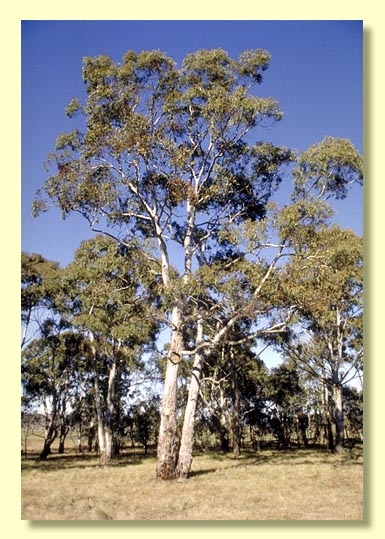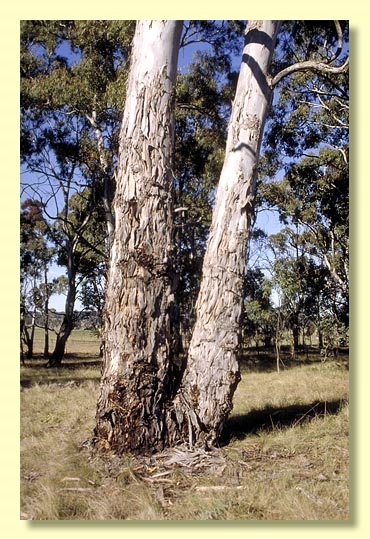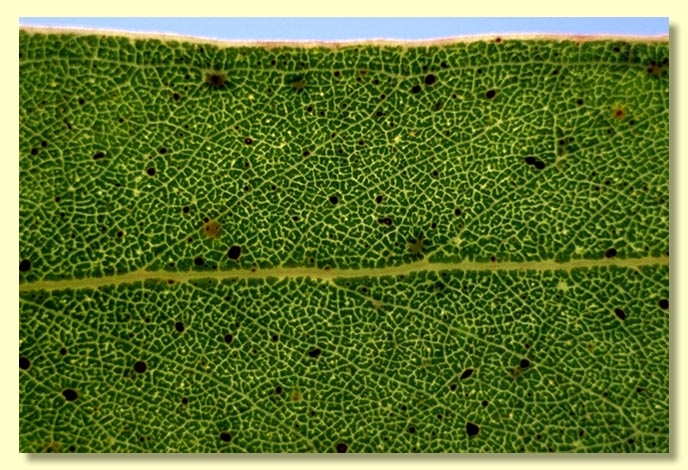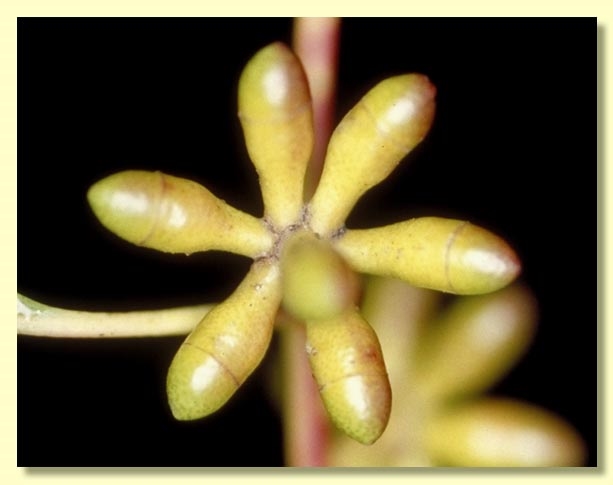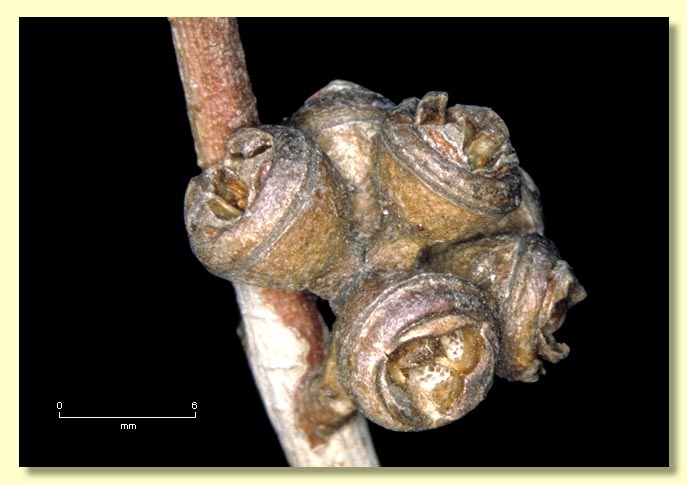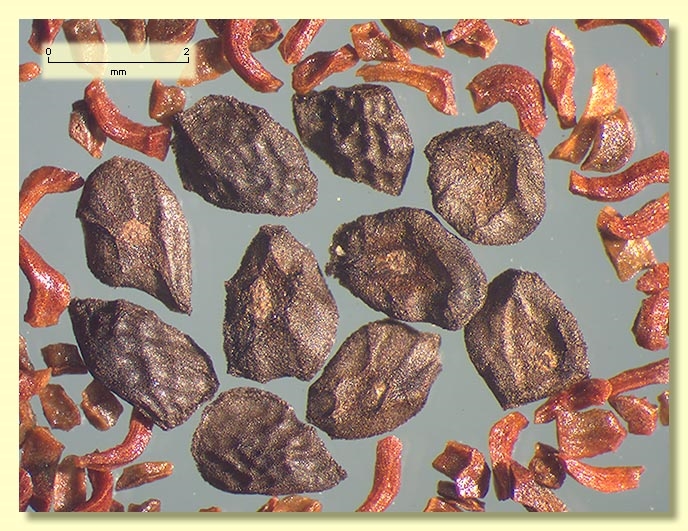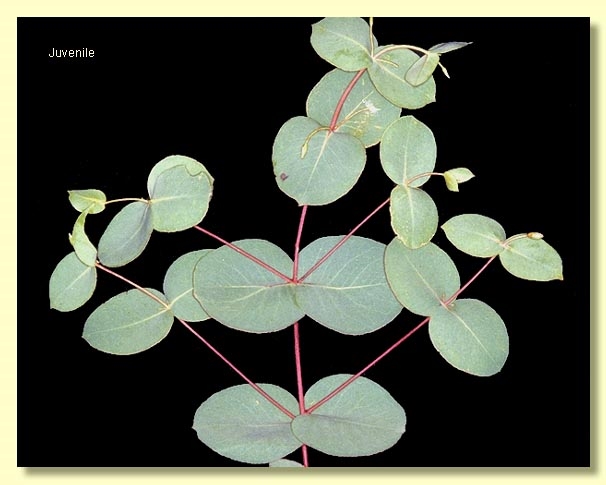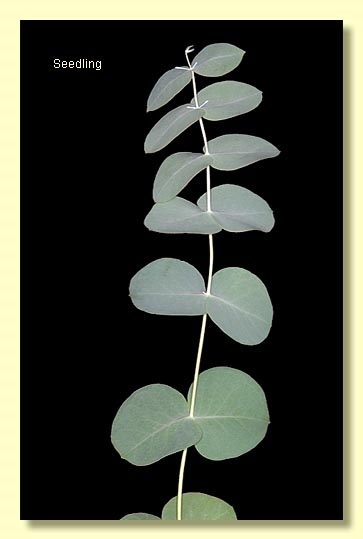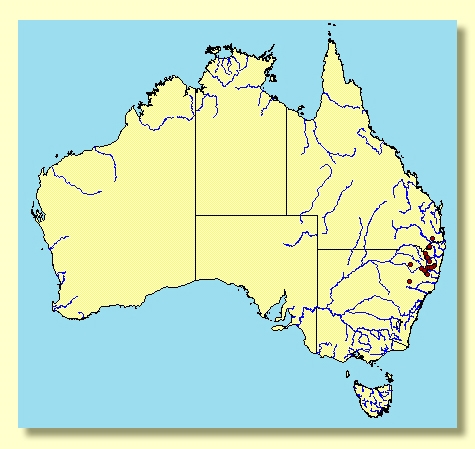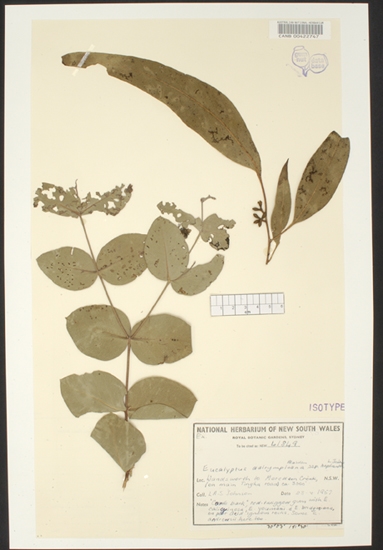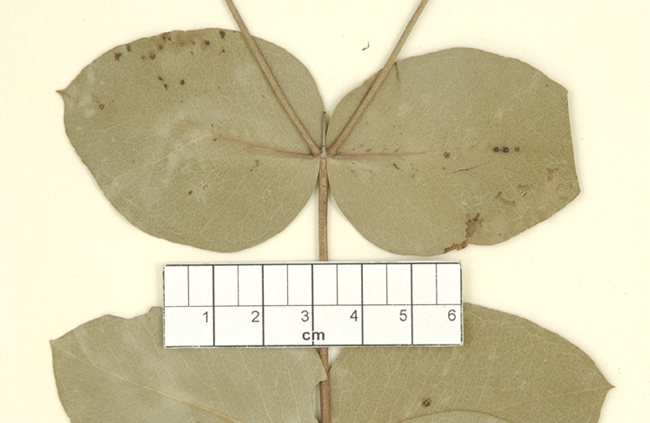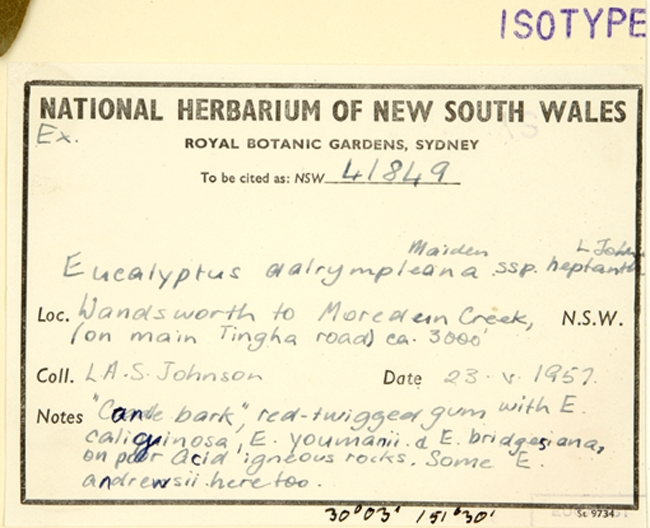Euclid - Online edition
Eucalyptus dalrympleana subsp. heptantha
Eucalyptus | Symphyomyrtus | Maidenaria | Euryotae | Viminales | Circulares
T: Wandsworth to Moredun Ck, NSW, 23 May 1957, L.A.S.Johnson NSW 41849; holo: NSW; iso: CANB, K.
Bark smooth throughout or with short stocking of persistent rough greyish bark; smooth bark yellow or white to cream with patches of grey, pink, brown and green, sometimes powdery, sometimes with horizontal black scars, often with ribbony crown.
Juvenile growth (coppice or field seedlings to 50 cm): stem rounded or square in cross-section, smooth or slightly warty; juvenile leaves opposite for many nodes, sessile, cordate to orbicular to ovate, 3–7 cm long, 2.5–6 cm wide, margin entire or crenulate, green or grey-green.
Adult leaves alternate, petiole 1.5–3 cm long; blade lanceolate to falcate, 7–24 cm long, 1.2–3.5 cm wide, flat or undulate, base tapering to petiole, concolorous, glossy, green, side-veins greater than 45° to midrib, moderately to densely reticulate, intramarginal vein parallel to and remote from margin, oil glands island, intersectional or obscure.
Inflorescence axillary unbranched, peduncles 0.5–1 cm long, buds 7 per umbel (3s sometimes present also on some trees), sessile or on pedicels to 0.5 cm long. Mature buds oblong to ovoid, 0.5–0.8 cm long, 0.2–0.5 cm wide, scar present, operculum conical to rounded, stamens irregularly flexed, anthers cuboid to oblong, versatile, dorsifixed, dehiscing by longitudinal slits (non-confluent), style long, stigma blunt, locules 3 or 4, the placentae each with 4 vertical ovule rows. Flowers white.
Fruit sessile or on pedicels to 0.3 cm long, cup-shaped, or hemispherical, 0.4–0.6 cm long, 0.5–0.8 cm wide, disc raised-oblique to almost vertical, or disc level, valves 3 or 4, exserted.
Seeds reddish brown, black or grey, 1.5–2.5 mm long, ovoid or flattened-ovoid, often pointed at one end, usually lacunose, dorsal surface shallowly pitted, hilum ventral.
Cultivated seedlings (measured at ca node 10): cotyledons bilobed; stems rounded in cross-section, usually non-glaucous; leaves opposite and sessile for many nodes, cordate to orbicular, 2.5–6.5 cm long, 1–7 cm wide, amplexicaul or base truncate, margin entire or subcrenulate, apex rounded to emarginate or sometimes pointed, dull, grey-green to green.
Flowering has been recorded in February and September.
Eucalyptus dalrympleana is a medium-sized to tall tree species of mountain country in far south-eastern Queensland, New South Wales, Victoria and South Australia (Mt Lofty Range only) and on upper slopes and plateaus in Tasmania. It is essentially smooth-barked but often with a very short stocking of ± persistent bark on the base of the trunk, and is essentially non-glaucous, having a crown of green lanceolate leaves, axillary clusters of buds, in threes in subsp. dalrympleana and predominantly sevens in subsp. heptantha, and cup-shaped fruit with valves partly exserted.
There are two subspecies:
E. dalrympleana subsp. dalrympleana
This subspecies has three buds per umbel and is widespread from the Central Tablelands of New South Wales to Victoria, South Australia and Tasmania. Populations of trees intermediate in form between E. dalrympleana subsp. dalrympleana and E. viminalis subsp. viminalis are common in Tasmania, especially at lower and intermediate altitudes (Williams & Potts, 1996, pp. 64-5), most obviously seen in the variation of juvenile leaf shape on coppice growth frequently seen trackside and on the forest floor.
E. dalrympleana subsp. heptantha
Usually has seven buds per umbel and occurs on the northern tablelands of New South Wales, extending to the north of Girraween and near Euky in the Darling Downs region of Queensland. Many populations on the Northern Tablelands, however, appear to be mixed as regards bud numbers, i.e. have umbels of seven and umbels of three on the same tree. It is distinguished from the Northern Tablelands endemic species, E. elliptica, by the more orbicular juvenile leaves (more elliptical in E. elliptica) and buds and fruit that taper into the short thickish pedicel (buds and fruit basally rounded and distinct from slender pedicel in E. elliptica).
In montane forests and woodlands Eucalyptus dalrympleana is distinguished from E. viminalis subsp. viminalis by the orbicular, cf. narrowly lanceolate, juvenile leaves and habitats generally of slopes and plateaus, cf. valleys, and from E. rubida by the light green to grey-green, non-glaucous juvenile leaves (branchlets, buds and fruit frequently glaucous and juveniles always glaucous in E. rubida). E. rubida occurs on nutritionally depleted, shallower soils in areas of cold air drainage compared with E. dalrympleana. Other three-budded species that grow in similar habitat and may be confused with E. dalrympleana are: E. chapmaniana, which has a rough-barked trunk, very ribbony branches and a blue-green crown; and E. glaucescens, which has often glaucous buds with operculum much shorter than the base of the bud, fruit more cylindrical-cupular rather than cupular-hemispherical fruit.
Eucalyptus dalrympleana belongs in Eucalyptus subgenus Symphyomyrtus section Maidenaria, a large group of species more or less restricted to south-eastern Australia, characterised by bilobed cotyledons, simple axillary inflorescences, buds with two opercula, stamens with versatile anthers and flattened seeds with a ventral hilum. Within this section, E. dalrympleana belongs in series Viminales subseries Circulares, having buds in threes or sevens, fruit with an ascending disc and exserted valves, and green to grey-green, sessile, orbicular juvenile leaves opposite for many pairs.
subsp. heptantha: Greek heptanthos, seven-flowered.

